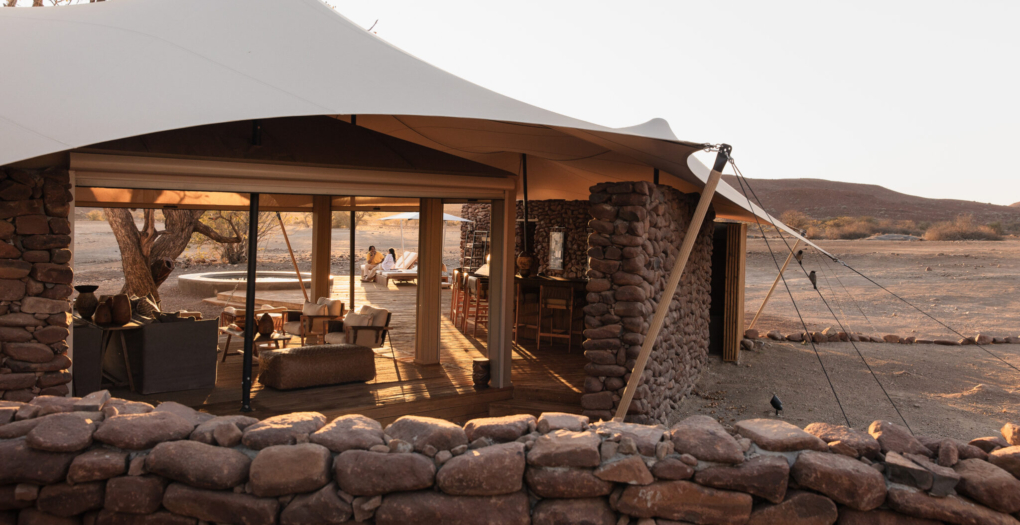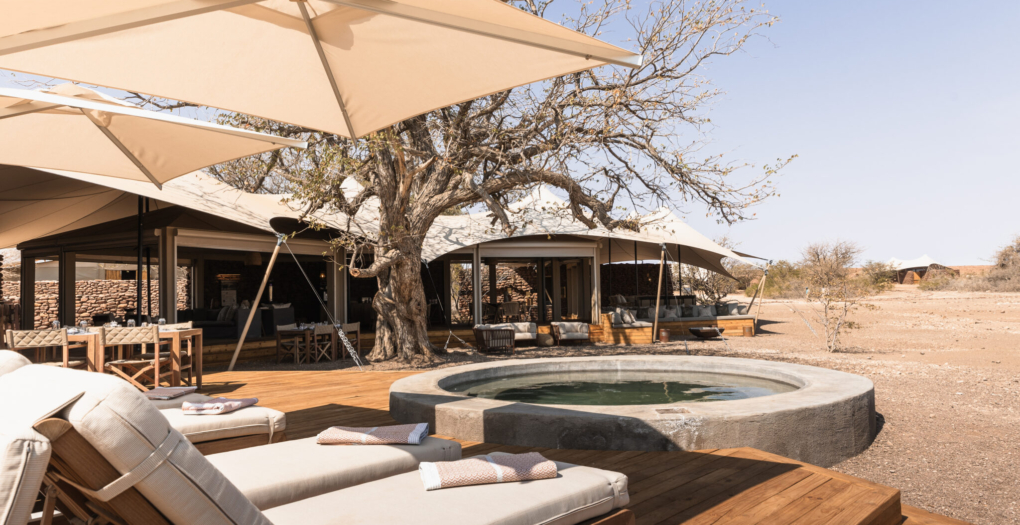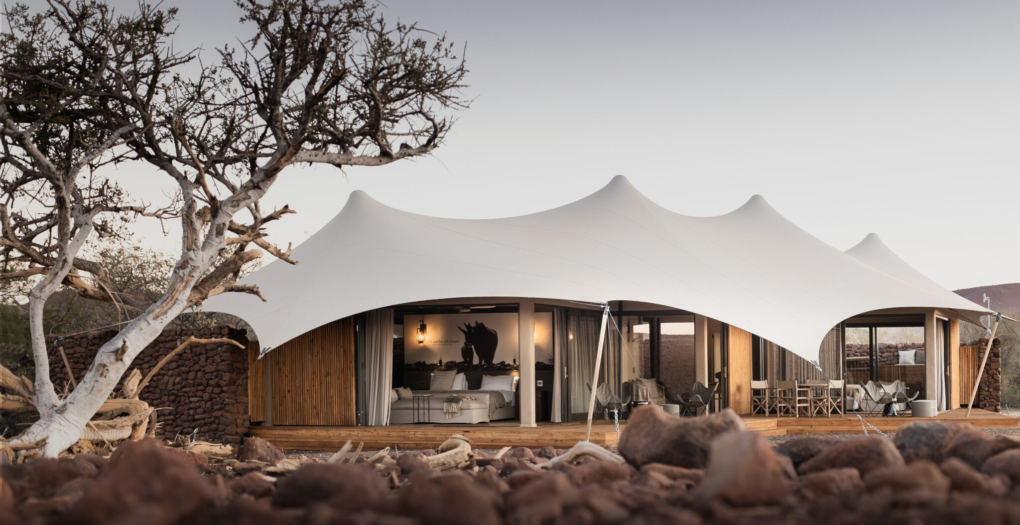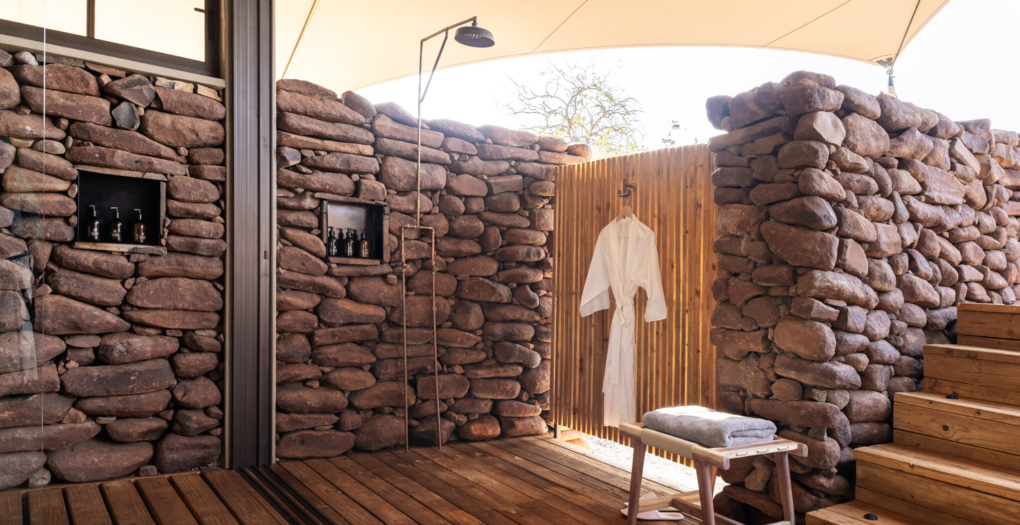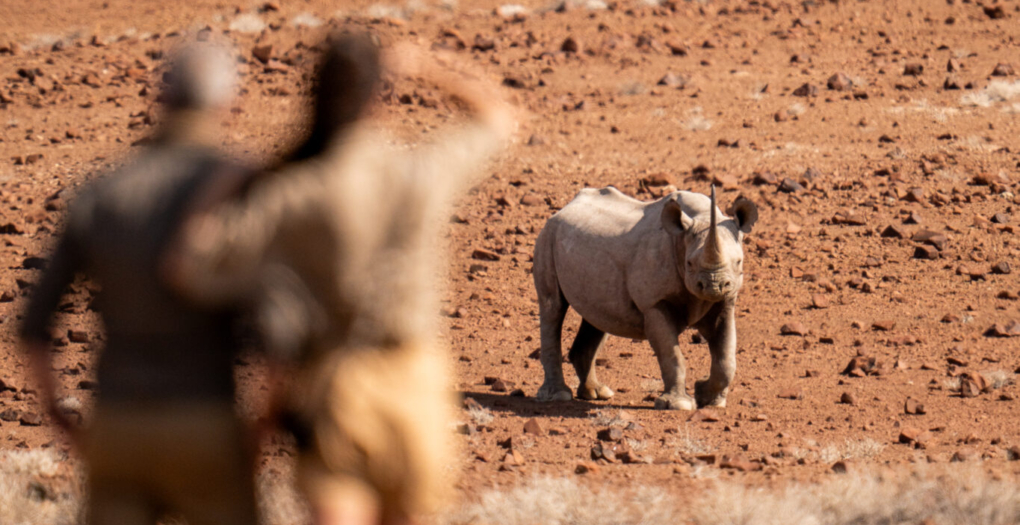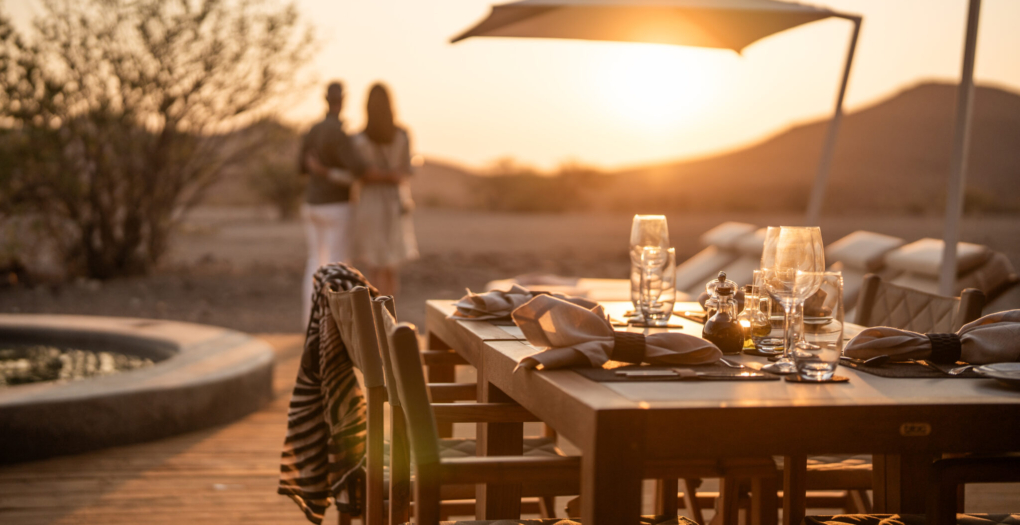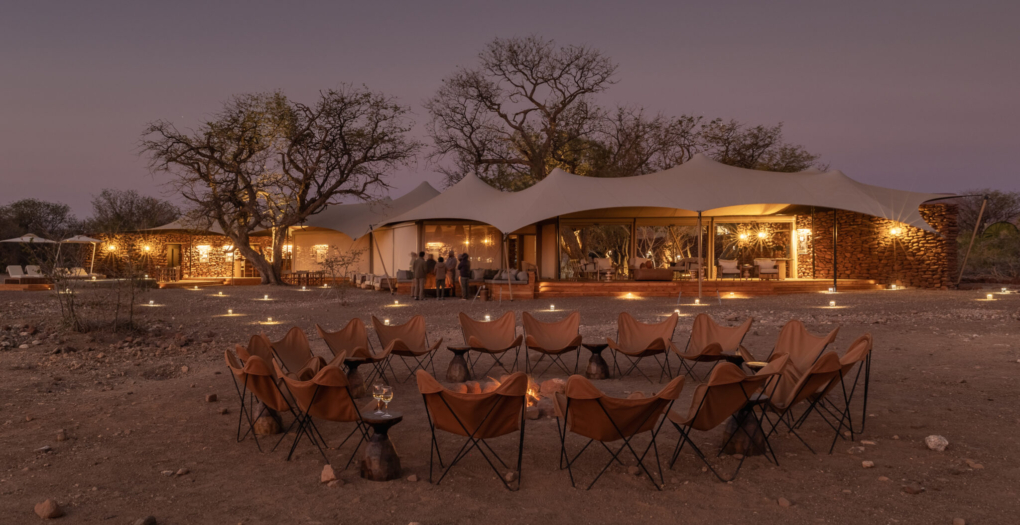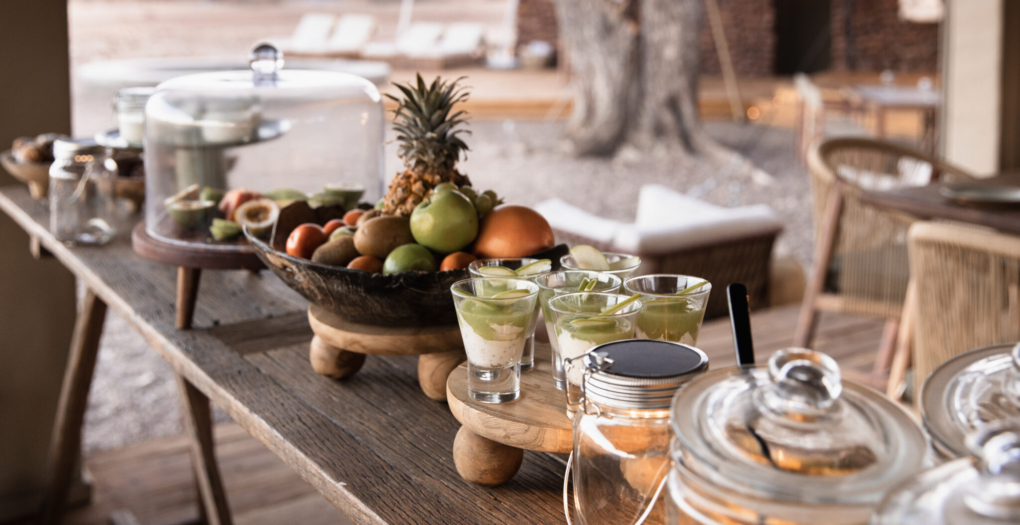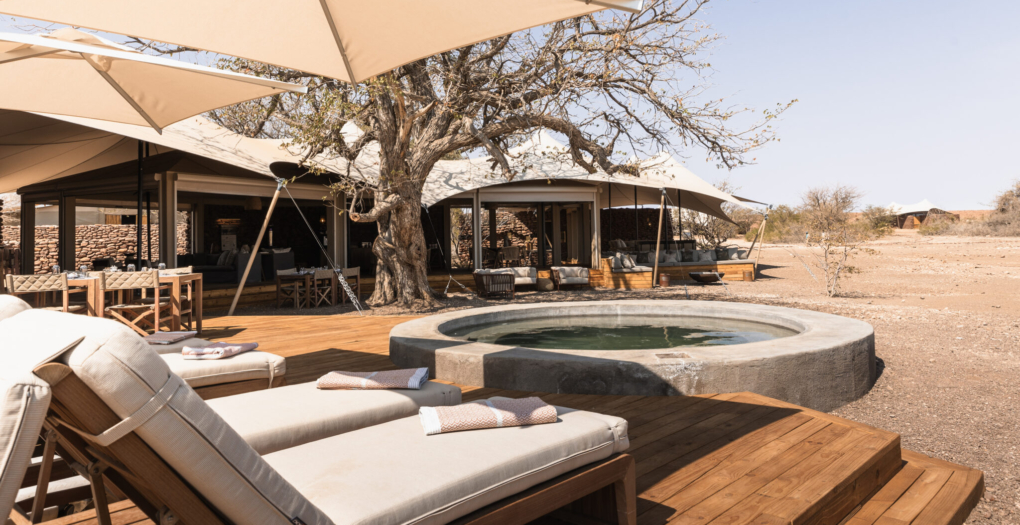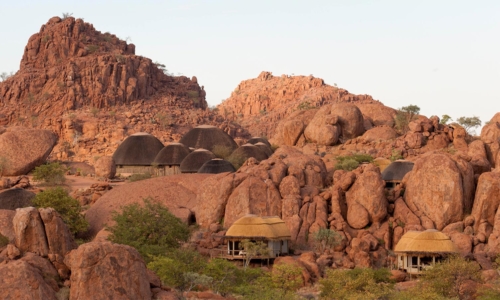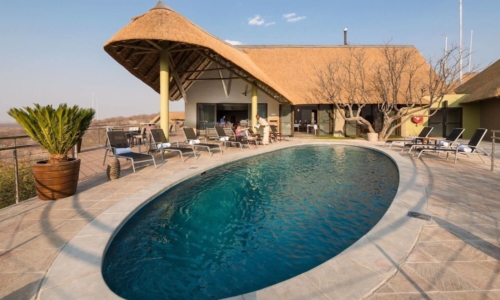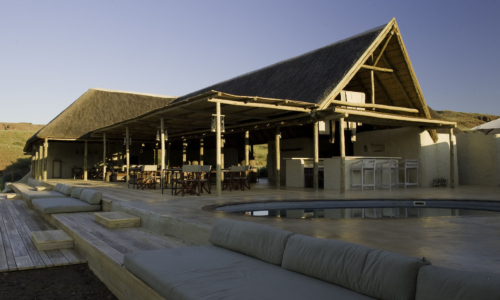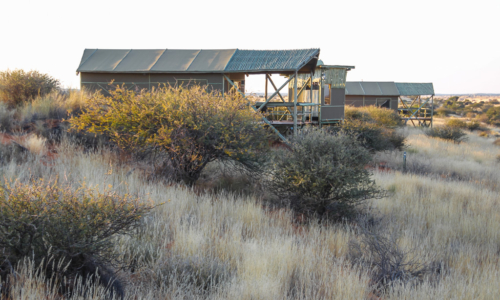Accommodations at the camp consist of eight Meru-style built on a raised deck. There are six twin-bedded tents and two double bedded tents to choose from. Each tent features an en-suite bathroom including a hand basin, a flush toilet, and a shower. For added privacy and relaxation, guests can sit on their front veranda to enjoy the sweeping views of scattered euphorbia and ancient welwitschia plants with the dramatic Etendeka Mountains in the background.
Lying among the rocky hills and vegetative scrub of the 3,417-square mile Palmwag Concession, the camp is privy to an environment of minimalist beauty that is home to a surprising variety of wildlife including the largest free roaming black rhino population in Africa. The camp is set in a wide valley that transforms into grassland when there is enough rain. The Concession’s freshwater springs also support healthy populations of desert-adapted elephant, Hartmann’s mountain zebra, giraffe, gemsbok, springbok, kudu and predators such as lion, cheetah, leopard, and brown and spotted hyena. There are also a large variety of bird species living here too.
Rhino tracking both in 4×4 and on foot is obviously the primary activity at the camp. After barely surviving extinction two decades ago, the rhino population has doubled since the formation of the SRT. Daily game drives are conducted by expert guides and provide an excellent opportunity to spot some of the other native wildlife. Guided nature walks take a closer look at the flora and fauna for lessons on how they adapt to live in this harsh environment. Full day outing around the Concession also include a delicious picnic lunch. Bird watchers can enjoy looking for Rüppell’s korhaan, Benguela long-billed lark, and possibly Herero chat. Verreauxs’ eagle is often sighted around rocky hillsides.
From the expansive viewing deck surrounding the common dining and lounge area, guests can take in the panoramic views of the surrounding desert and Etendeka Mountains. During the heat of the day, the camp’s refreshing swimming pool is the best place to cool off and relax. At night, the open fire pit is the place to gather with an after-dinner drink and a story.


- Anderssons at Ongava
- Babson House
- Camp Kipwe
- Canyon Lodge
- Canyon Roadhouse
- Canyon Village
- Cape Cross Lodge
- Chobe Savanna Lodge
- Damara Mopane Lodge
- Damaraland Camp
- Dead Valley Lodge
- Desert Hills Glamping Camp
- Desert Homestead
- Desert Homestead Outpost
- Desert Rhino Camp
- Dolomite Camp
- Doro Nawas Camp
- Eagle’s Nest Lodge
- Erongo Wilderness Lodge
- Etosha Heights Safari House
- Etosha Mountain Lodge
- Etosha Safari Camp
- Etosha Safari Lodge
- Fish River Lodge
- Fort Sesfontein Lodge
- Grootberg Lodge
- Halali Camp
- Hoanib Skeleton Coast Camp
- Hoanib Valley Camp
- Ichingo Chobe River Lodge
- Kalahari Anib Lodge
- Kalahari Farmhouse
- Khorixas Rest Camp
- Kulala Desert Lodge
- Kwessi Dunes
- Little Kulala
- Little Ongava
- Malansrus Tented Camp
- Mowani Mountain Camp
- Mushara Bush Camp
- Mushara Lodge
- Mushara Outpost
- Naankuse Lodge
- Namib Desert Lodge
- Namushasha River Lodge
- Namutoni Camp
- Nhoma Safari Camp
- Okahirongo Elephant Lodge
- Okahirongo River Camp
- Okaukuejo Camp
- Okonjima Bush Camp
- Okonjima Bush Suite
- Okonjima Grand African Villa
- Okonjima Plains Camp
- Onduli Ridge
- Ongava Lodge
- Ongava Tented Camp
- Onguma Bush Camp
- Onguma Etosha Aoba Lodge
- Onguma Tented Camp
- Onguma The Fort
- Onguma Tree Top Camp
- Onkoshi Camp
- Ozondjou Trails
- Popa Falls Camp
- River Crossing Lodge
- Safarihoek Lodge
- Serra Cafema Camp
- Shipwreck Lodge
- Sossus Dune Lodge
- Sossusvlei Desert Lodge
- Terrace Bay Camp
- Teufelskrallen Tented Lodge
- Villa Mushara
- Wolwedans Boulders Safari Camp
- Wolwedans Dune Camp
- Wolwedans Dunes Lodge
- Wolwedans Mountain View Suite
- Wolwedans Private Camp
- Anderssons at Ongava
- Babson House
- Camp Kipwe
- Canyon Lodge
- Canyon Roadhouse
- Canyon Village
- Cape Cross Lodge
- Chobe Savanna Lodge
- Damara Mopane Lodge
- Damaraland Camp
- Dead Valley Lodge
- Desert Hills Glamping Camp
- Desert Homestead
- Desert Homestead Outpost
- Desert Rhino Camp
- Dolomite Camp
- Doro Nawas Camp
- Eagle’s Nest Lodge
- Erongo Wilderness Lodge
- Etosha Heights Safari House
- Etosha Mountain Lodge
- Etosha Safari Camp
- Etosha Safari Lodge
- Fish River Lodge
- Fort Sesfontein Lodge
- Grootberg Lodge
- Halali Camp
- Hoanib Skeleton Coast Camp
- Hoanib Valley Camp
- Ichingo Chobe River Lodge
- Kalahari Anib Lodge
- Kalahari Farmhouse
- Khorixas Rest Camp
- Kulala Desert Lodge
- Kwessi Dunes
- Little Kulala
- Little Ongava
- Malansrus Tented Camp
- Mowani Mountain Camp
- Mushara Bush Camp
- Mushara Lodge
- Mushara Outpost
- Naankuse Lodge
- Namib Desert Lodge
- Namushasha River Lodge
- Namutoni Camp
- Nhoma Safari Camp
- Okahirongo Elephant Lodge
- Okahirongo River Camp
- Okaukuejo Camp
- Okonjima Bush Camp
- Okonjima Bush Suite
- Okonjima Grand African Villa
- Okonjima Plains Camp
- Onduli Ridge
- Ongava Lodge
- Ongava Tented Camp
- Onguma Bush Camp
- Onguma Etosha Aoba Lodge
- Onguma Tented Camp
- Onguma The Fort
- Onguma Tree Top Camp
- Onkoshi Camp
- Ozondjou Trails
- Popa Falls Camp
- River Crossing Lodge
- Safarihoek Lodge
- Serra Cafema Camp
- Shipwreck Lodge
- Sossus Dune Lodge
- Sossusvlei Desert Lodge
- Terrace Bay Camp
- Teufelskrallen Tented Lodge
- Villa Mushara
- Wolwedans Boulders Safari Camp
- Wolwedans Dune Camp
- Wolwedans Dunes Lodge
- Wolwedans Mountain View Suite
- Wolwedans Private Camp

Accommodations at the camp consist of eight Meru-style built on a raised deck. There are six twin-bedded tents and two double bedded tents to choose from. Each tent features an en-suite bathroom including a hand basin, a flush toilet, and a shower. For added privacy and relaxation, guests can sit on their front veranda to enjoy the sweeping views of scattered euphorbia and ancient welwitschia plants with the dramatic Etendeka Mountains in the background.
Lying among the rocky hills and vegetative scrub of the 3,417-square mile Palmwag Concession, the camp is privy to an environment of minimalist beauty that is home to a surprising variety of wildlife including the largest free roaming black rhino population in Africa. The camp is set in a wide valley that transforms into grassland when there is enough rain. The Concession’s freshwater springs also support healthy populations of desert-adapted elephant, Hartmann’s mountain zebra, giraffe, gemsbok, springbok, kudu and predators such as lion, cheetah, leopard, and brown and spotted hyena. There are also a large variety of bird species living here too.
Rhino tracking both in 4×4 and on foot is obviously the primary activity at the camp. After barely surviving extinction two decades ago, the rhino population has doubled since the formation of the SRT. Daily game drives are conducted by expert guides and provide an excellent opportunity to spot some of the other native wildlife. Guided nature walks take a closer look at the flora and fauna for lessons on how they adapt to live in this harsh environment. Full day outing around the Concession also include a delicious picnic lunch. Bird watchers can enjoy looking for Rüppell’s korhaan, Benguela long-billed lark, and possibly Herero chat. Verreauxs’ eagle is often sighted around rocky hillsides.
From the expansive viewing deck surrounding the common dining and lounge area, guests can take in the panoramic views of the surrounding desert and Etendeka Mountains. During the heat of the day, the camp’s refreshing swimming pool is the best place to cool off and relax. At night, the open fire pit is the place to gather with an after-dinner drink and a story.

- Anderssons at Ongava
- Babson House
- Camp Kipwe
- Canyon Lodge
- Canyon Roadhouse
- Canyon Village
- Cape Cross Lodge
- Chobe Savanna Lodge
- Damara Mopane Lodge
- Damaraland Camp
- Dead Valley Lodge
- Desert Hills Glamping Camp
- Desert Homestead
- Desert Homestead Outpost
- Desert Rhino Camp
- Dolomite Camp
- Doro Nawas Camp
- Eagle’s Nest Lodge
- Erongo Wilderness Lodge
- Etosha Heights Safari House
- Etosha Mountain Lodge
- Etosha Safari Camp
- Etosha Safari Lodge
- Fish River Lodge
- Fort Sesfontein Lodge
- Grootberg Lodge
- Halali Camp
- Hoanib Skeleton Coast Camp
- Hoanib Valley Camp
- Ichingo Chobe River Lodge
- Kalahari Anib Lodge
- Kalahari Farmhouse
- Khorixas Rest Camp
- Kulala Desert Lodge
- Kwessi Dunes
- Little Kulala
- Little Ongava
- Malansrus Tented Camp
- Mowani Mountain Camp
- Mushara Bush Camp
- Mushara Lodge
- Mushara Outpost
- Naankuse Lodge
- Namib Desert Lodge
- Namushasha River Lodge
- Namutoni Camp
- Nhoma Safari Camp
- Okahirongo Elephant Lodge
- Okahirongo River Camp
- Okaukuejo Camp
- Okonjima Bush Camp
- Okonjima Bush Suite
- Okonjima Grand African Villa
- Okonjima Plains Camp
- Onduli Ridge
- Ongava Lodge
- Ongava Tented Camp
- Onguma Bush Camp
- Onguma Etosha Aoba Lodge
- Onguma Tented Camp
- Onguma The Fort
- Onguma Tree Top Camp
- Onkoshi Camp
- Ozondjou Trails
- Popa Falls Camp
- River Crossing Lodge
- Safarihoek Lodge
- Serra Cafema Camp
- Shipwreck Lodge
- Sossus Dune Lodge
- Sossusvlei Desert Lodge
- Terrace Bay Camp
- Teufelskrallen Tented Lodge
- Villa Mushara
- Wolwedans Boulders Safari Camp
- Wolwedans Dune Camp
- Wolwedans Dunes Lodge
- Wolwedans Mountain View Suite
- Wolwedans Private Camp
- Anderssons at Ongava
- Babson House
- Camp Kipwe
- Canyon Lodge
- Canyon Roadhouse
- Canyon Village
- Cape Cross Lodge
- Chobe Savanna Lodge
- Damara Mopane Lodge
- Damaraland Camp
- Dead Valley Lodge
- Desert Hills Glamping Camp
- Desert Homestead
- Desert Homestead Outpost
- Desert Rhino Camp
- Dolomite Camp
- Doro Nawas Camp
- Eagle’s Nest Lodge
- Erongo Wilderness Lodge
- Etosha Heights Safari House
- Etosha Mountain Lodge
- Etosha Safari Camp
- Etosha Safari Lodge
- Fish River Lodge
- Fort Sesfontein Lodge
- Grootberg Lodge
- Halali Camp
- Hoanib Skeleton Coast Camp
- Hoanib Valley Camp
- Ichingo Chobe River Lodge
- Kalahari Anib Lodge
- Kalahari Farmhouse
- Khorixas Rest Camp
- Kulala Desert Lodge
- Kwessi Dunes
- Little Kulala
- Little Ongava
- Malansrus Tented Camp
- Mowani Mountain Camp
- Mushara Bush Camp
- Mushara Lodge
- Mushara Outpost
- Naankuse Lodge
- Namib Desert Lodge
- Namushasha River Lodge
- Namutoni Camp
- Nhoma Safari Camp
- Okahirongo Elephant Lodge
- Okahirongo River Camp
- Okaukuejo Camp
- Okonjima Bush Camp
- Okonjima Bush Suite
- Okonjima Grand African Villa
- Okonjima Plains Camp
- Onduli Ridge
- Ongava Lodge
- Ongava Tented Camp
- Onguma Bush Camp
- Onguma Etosha Aoba Lodge
- Onguma Tented Camp
- Onguma The Fort
- Onguma Tree Top Camp
- Onkoshi Camp
- Ozondjou Trails
- Popa Falls Camp
- River Crossing Lodge
- Safarihoek Lodge
- Serra Cafema Camp
- Shipwreck Lodge
- Sossus Dune Lodge
- Sossusvlei Desert Lodge
- Terrace Bay Camp
- Teufelskrallen Tented Lodge
- Villa Mushara
- Wolwedans Boulders Safari Camp
- Wolwedans Dune Camp
- Wolwedans Dunes Lodge
- Wolwedans Mountain View Suite
- Wolwedans Private Camp







